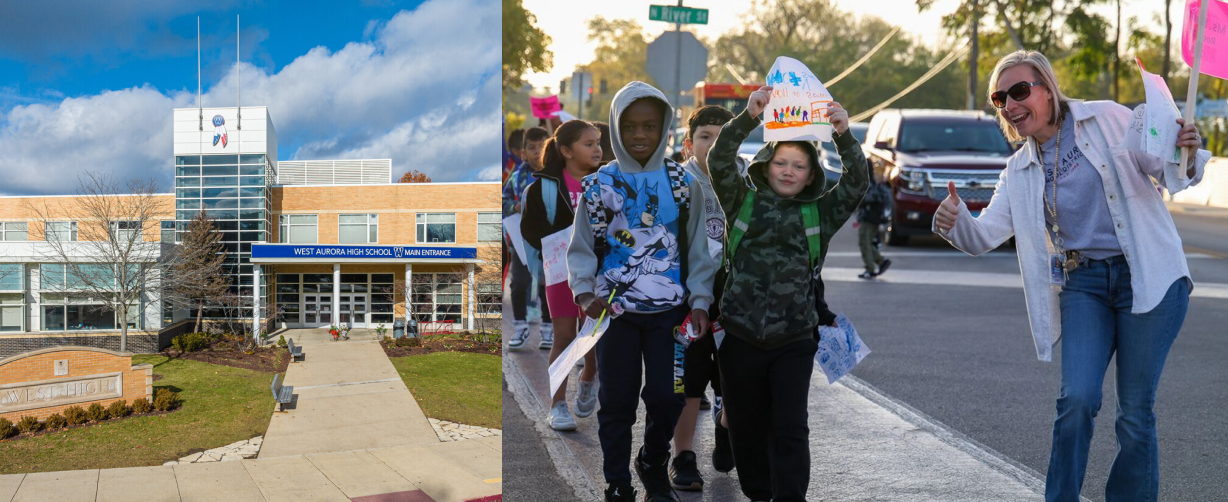Chronic absenteeism has emerged as one of the most pressing issues in K-12 education, particularly since 2020. Schools across the nation are grappling with rising absentee rates, which have been linked to lower academic achievement and social disengagement. In fact, research from Attendance Works reveals that students who miss 10% or more of the school year are significantly more likely to fall behind academically and even drop out of school altogether.
To address the attendance and class-avoidance issues they’ve seen in their district, the West Aurora School District in Illinois has turned to Wayfinder’s future-ready skills curriculum to transform the district’s approach to chronic absenteeism. Through an emphasis on self-awareness, belonging, agency, and accountability, West Aurora has found a way to re-engage students and improve attendance rates across grade levels.
Need help addressing chronic absenteeism at your school or district? Get resources here.
The Connection Between Whole-Student Education + Attendance
Whole-student education programs like Wayfinder have become a crucial tool in addressing issues like absenteeism, helping students build critical life skills like self-awareness, relationship building, and responsible decision-making. Research shows that students who participate in school-based personal and community development programs demonstrate improved academic performance, better emotional regulation, and stronger relationships with their peers and teachers. These factors all contribute to better school attendance, as students who feel connected to their school environment are more likely to attend regularly.
At West Aurora, the use of Wayfinder to address absenteeism focuses on creating an environment where students feel a sense of agency and belonging—two factors directly tied to consistent attendance.
Building Agency + Accountability: The Blackhawk Reorientation Program
One of West Aurora’s most impactful interventions is the Blackhawk Reorientation program at West Aurora High School. The program helps students who have been chronically absent or disengaged from school by integrating Wayfinder’s lessons directly into their daily routines.
Andre Meeks, the Academic Interventionist at West Aurora High School, explains how the Blackhawk Reorientation program uses Wayfinder to directly address absenteeism: “Our program, Blackhawk Reorientation, is the central hub for where we apply Wayfinder in particular, directly in relation to absenteeism and class avoidance.” By focusing on skills like accountability and agency, students are encouraged to take ownership of their attendance and behavior.
Meeks emphasizes the importance of linking agency—students’ sense of control over their actions—with accountability. “We find that our students can draw a direct line between agency and accountability,” he says. “They can start to see, naturally, how the consequences are a result of their behavior.” This connection is crucial in helping students understand that their choices, including whether they attend class, have direct and meaningful outcomes. As students realize that their actions lead to specific consequences, many begin to make better choices.
Meeks has observed significant improvements in attendance and academic performance as a result. “We’ve got some kids who are doing really well, going to pass all their classes because they had a plan, and they knew that these things were in their control.”
Encouraging Self-Reflection
Another aspect at the heart of West Aurora’s approach to addressing absenteeism is helping students develop a deeper understanding of their behaviors and motivations. Many students who are chronically absent or avoid class are unaware of the underlying factors driving their disengagement. Activities like Wayfinder’s Self-Awareness Check-In have proven pivotal in encouraging students to recognize the impact of their needs, emotions, and personal challenges. Meeks explains, “We really start our students off with the Self-Awareness Check-In. Here, take some time to reflect about you—what are your needs, what are the things that make you feel safe in a particular environment, all of the stuff that's already baked into the [Wayfinder] curriculum.” These moments of reflection allow students to pinpoint the reasons behind their absences, whether it’s anxiety, a lack of connection to the school environment, or academic struggles.
Meeks explains, “We really start our students off with the Self-Awareness Check-In. Here, take some time to reflect about you—what are your needs, what are the things that make you feel safe in a particular environment, all of the stuff that's already baked into the [Wayfinder] curriculum.” These moments of reflection allow students to pinpoint the reasons behind their absences, whether it’s anxiety, a lack of connection to the school environment, or academic struggles.
Demetrice Stephens, Administrator of Student Success Programs at West Aurora High School, shares how powerful these self-reflections can be. He mentions a different Wayfinder activity called The Should List that sparked transformative outcomes in the classrooms he observed, noting how it helped bring to light things that they knew but were having trouble addressing—putting words to the reasons behind their actions for what may have been the first time. By articulating their challenges, students could better understand their behaviors and take steps toward improvement. This process of self-awareness is critical to breaking the cycle of chronic absenteeism.
Engaging Younger Students with Interactive Scenarios
To address chronic absenteeism and inconsistent attendance at the elementary level, West Aurora has incorporated Wayfinder activities that are engaging, interactive, and tailored to younger students.
Joshua Toopes, a Student Success Administrator in the district, shares a story from a fourth grade classroom where absenteeism was a significant concern. “[The teacher] had several students who were absent all the time,” Toopes recalls. “We started running Wayfinder activities. She actually gave them the Waypoints assessment, and it came back and suggested the activity The Water Balloon Incident,” an activity that guides students through a conflict resolution scenario.
The results were immediate and encouraging. “We spent 40 minutes talking, the kids were into it,” Toopes says. “And the next day, some of those other kids showed up that weren’t coming. And they were like, ‘I heard about this water balloon incident.’” This simple but powerful activity not only engaged the students but also sparked excitement and curiosity, motivating previously absent students to return to class.
Fostering Belonging: A Key to Student Engagement
At West Aurora, belonging is a key focus of the district’s use of Wayfinder. Andre Meeks points out that belonging is often the starting point for addressing absenteeism: “For a lot of our students, regardless of grade level, belonging is where we have to start.” Wayfinder activities are designed to foster connection, trust, and community among students and teachers. Through group discussions, collaborative projects, and reflective exercises, students build stronger relationships with their peers and educators, which in turn improves their school attendance.
Toopes highlights the importance of this connection: “[Students] started seeing that their differences were actually similarities. So it was really neat to watch. And we started seeing some of those kids that were absent a lot, come into school.” When students feel valued and understood, they are more likely to show up, engage, and participate in their education.
Takeaway Attendance Tips from West Aurora
West Aurora’s success with Wayfinder offers several best practices for educators looking to address chronic absenteeism through whole-student education. While no individual effort can be expected to produce immediate results, West Aurora’s combined strategies can help envision a way forward for schools and districts struggling with similar attendance issues. - Start with Self-Reflection: Activities like Wayfinder’s Self-Awareness Check-In help students identify the personal challenges contributing to their absences and give words to their barriers to attendance.
- Foster Belonging: Build connections among students and teachers by creating opportunities for collaboration and group discussions that help students feel included and valued.
- Develop Agency + Accountability: Help students understand the connection between their actions and their consequences. Encourage students to take ownership of their attendance and academic success by setting personal goals.
- Use Relevant Activities to Re-Engage Students: Choose activities that resonate with students’ experiences. Activities like The Water Balloon Incident can spark meaningful conversations and motivate students to come to school.
West Aurora School District’s use of Wayfinder to address chronic absenteeism demonstrates the power of whole-student education in fostering student success. Through a focus on self-awareness, belonging, agency, and accountability, students from elementary to high school are learning to take responsibility for their attendance and re-engage with their school communities. By creating a supportive environment where students feel connected, understood, and empowered, West Aurora is making significant strides in helping students thrive in school and build healthy habits for the future.





